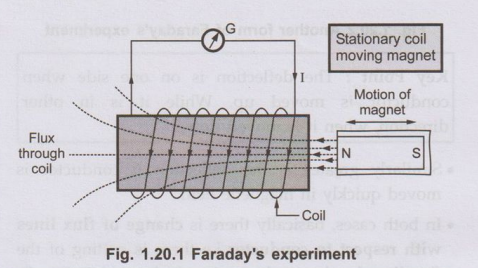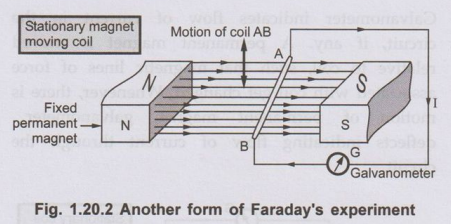Electrical Machines: Unit I: a. Magnetic Circuits and Electromagnetism
Faraday's Experiment
Key Point : The galvanometer deflects in one direction, when magnet is moved towards a coil. It deflects in other direction, when moved away from the coil.
Faraday's
Experiment
•
Let us study first the experiment conducted by Faraday to get understanding of
electromagnetic induction
•
Consider a coil having ‘N' turns connected to a galvanometer as shown in the
Fig. 1.20.1. Galvanometer indicates flow of current in the circuit, if any. A
permanent magnet is moved relative to coil, such that magnetic lines of force
associated with coil get changed. Whenever, there is motion of permanent
magnet, galvanometer deflects indicating flow of current through the circuit.

Key Point :
The galvanometer deflects in one direction, when magnet is moved towards a
coil. It deflects in other direction, when moved away from the coil.
•
The deflection continues as long as motion of magnet exists. More quickly the
magnet is moved, the greater is the deflection. Now deflection of galvanometer
indicates flow of current. But to exist flow of current there must be presence
of e.m.f. Hence such movement of flux lines with respect to coil generates an
e.m.f. which drives current through the coil. This is the situation where coil
in which e.m.f. is generated is fixed and magnet is moved to create relative
motion of flux with respect to coil.
• Similar observations can be made by moving a
coil in the magnetic field of fixed permanent magnet, creating relative motion
between flux and coil. This arrangement is shown in the Fig. 1.20.2. The coil
AB is moved by some external means in the magnetic field of fixed permanent
magnet. Coil is connected to galvanometer.
•
Whenever conductor AB is moved in the direction shown in the Fig. 1.20.2 the
galvanometer deflects indicating flow of current through coil AB.

Key Point :
The deflection is on one side when conductor is moved up. While it is in other
direction, when it is moved down.
•
Similarly greater is the deflection if conductor is moved quickly in magnetic
field.
•
In both cases, basically there is change of flux lines with respect to
conductor i.e there is cutting of the flux lines by the conductor in which
e.m.f. induced.
• With this experiment Faraday stated laws
called Faraday's Laws of Electromagnetic Induction.
This phenomenon of cutting of flux
lines by the conductor to get the induced e.m.f. in the conductor or coil is
called electromagnetic induction.
Thus,
to have induced e.m.f. there must exist,
1)
A coil or conductor.
2) A magnetic field (permanent magnet or electromagnet).
3)
Relative motion between conductor and magnetic flux (achieved by moving
conductor with respect to flux or moving with respect to conductor.)
Key Point :
The e.m.f. exists as long as relative motion persists.
Electrical Machines: Unit I: a. Magnetic Circuits and Electromagnetism : Tag: : - Faraday's Experiment
Related Topics
Related Subjects
Electrical Machines I
EE3303 EM 1 3rd Semester EEE Dept | 2021 Regulation | 3rd Semester EEE Dept 2021 Regulation
